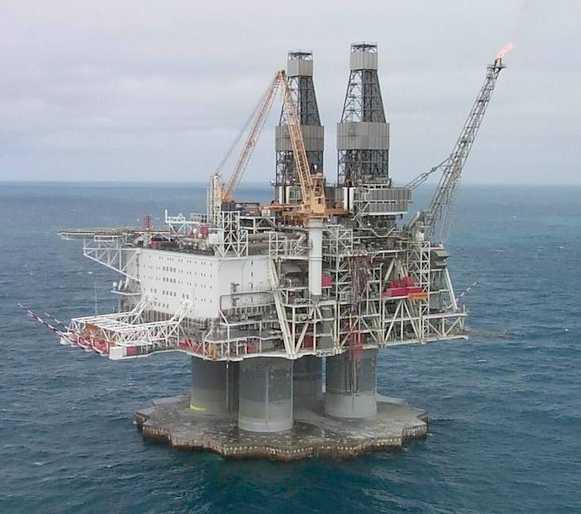Before there was an understanding of what natural gas was, it posed somewhat of a mystery to man. Sometimes, such things as lightning strikes would ignite natural gas that was escaping from under the earth's crust. This would create a fire coming from the earth, burning the natural gas as it seeped out from underground. These fires puzzled most early civilizations, and were the root of much myth and superstition. One of the most famous of these types of flames was found in ancient Greece, on Mount Parnassus approximately 1,000 B.C. A goat herdsman came across what looked like a 'burning spring', a flame rising from a fissure in the rock. The Greeks, believing it to be of divine origin, built a temple on the flame. This temple housed a priestess who was known as the Oracle of Delphi, giving out prophecies she claimed were inspired by the flame.
These types of springs became prominent in the religions of India, Greece, and Persia. Unable to explain where these fires came from, they were often regarded as divine, or supernatural. It wasn't until about 500 B.C. that the Chinese discovered the potential to use these fires to their advantage. Finding places where gas was seeping to the surface, the Chinese formed crude pipelines out of bamboo shoots to transport the gas, where it was used to boil sea water, separating the salt and making it drinkable.
Britain was the first country to commercialize the use of natural gas. Around 1785, natural gas produced from coal was used to light houses, as well as streetlights.
The Oracle at Delphi, Greece
Manufactured natural gas of this type (as opposed to naturally occurring gas) was first brought to the United States in 1816, when it was used to light the streets of Baltimore, Maryland. However, this manufactured gas was much less efficient, and less environmentally friendly, than modern natural gas that comes from underground.
Naturally occurring natural gas was discovered and identified in America as early as 1626, when French explorers discovered natives igniting gases that were seeping into and around Lake Erie. The American natural gas industry got its beginnings in this area. In 1859, Colonel Edwin Drake (a former railroad conductor who adopted the title 'Colonel' to impress the townspeople) dug the first well. Drake hit oil and natural gas at 69 feet below the surface of the earth.
A Reconstruction of 'Colonel' Drake's First Well in Titusville, Pa
Most in the industry characterise this well as the beginning of the natural gas industry in America. A two-inch diameter pipeline was built, running 5 and ½ miles from the well to the village of Titusville, Pennsylvania. The construction of this pipeline proved that natural gas could be brought safely and relatively easily from its underground source to be used for practical purposes.
In 1821, the first well specifically intended to obtain natural gas was dug in Fredonia, New York, by William Hart. After noticing gas bubbles rising to the surface of a creek, Hart dug a 27 foot well to try and obtain a larger flow of gas to the surface. Hart is regarded by many as the 'father of natural gas' in America. Expanding on Hart's work, the Fredonia Gas Light Company was eventually formed, becoming being the first American natural gas company.
A Natural Gas Streetlight
During most of the 19th century, natural gas was used almost exclusively as a source of light. Without a pipeline infrastructure, it was difficult to transport the gas very far, or into homes to be used for heating or cooking. Most of the natural gas produced in this era was manufactured from coal, as opposed to transported from a well. Near the end of the 19th century, with the rise of electricity, natural gas lights were converted to electric lights. This led producers of natural gas to look for new uses for their product.
In 1885, Robert Bunsen invented what is now known as the Bunsen burner. He managed to create a device that mixed natural gas with air in the right proportions, creating a flame that could be safely used for cooking and heating. The invention of the Bunsen burner opened up new opportunities for the use of natural gas in America, and throughout the world. The invention of temperature-regulating thermostatic devices allowed for better use of the heating potential of natural gas, allowing the temperature of the flame to be adjusted and monitored.
Without any way to transport it effectively, natural gas discovered pre-WWII was usually just allowed to vent into the atmosphere, or burnt, when found alongside coal and oil, or simply left in the ground when found alone.
One of the first lengthy pipelines was constructed in 1891. This pipeline was 120 miles long, and carried natural gas from wells in central Indiana to the city of Chicago. However, this early pipeline was very rudimentary, and was not very efficient at transporting natural gas. It wasn't until the 1920's that any significant effort was put into building a pipeline infrastructure. However, it wasn't until after the World War II that welding techniques, pipe rolling, and metallurgical advances allowed for the construction of reliable pipelines. This post-war pipeline construction boom lasted well into the 60's, and allowed for the construction of thousands of miles of pipeline in America.
Once the transportation of natural gas was possible, new uses for natural gas were discovered. These included using natural gas to heat homes and operate appliances such as water heaters and oven ranges. Industry began to use natural gas in manufacturing and processing plants. Also, natural gas was used to heat boilers used to generate electricity. The transportation infrastructure had made natural gas easy to obtain, and it was becoming an increasingly popular form of energy
Source
NaturalGas.org









